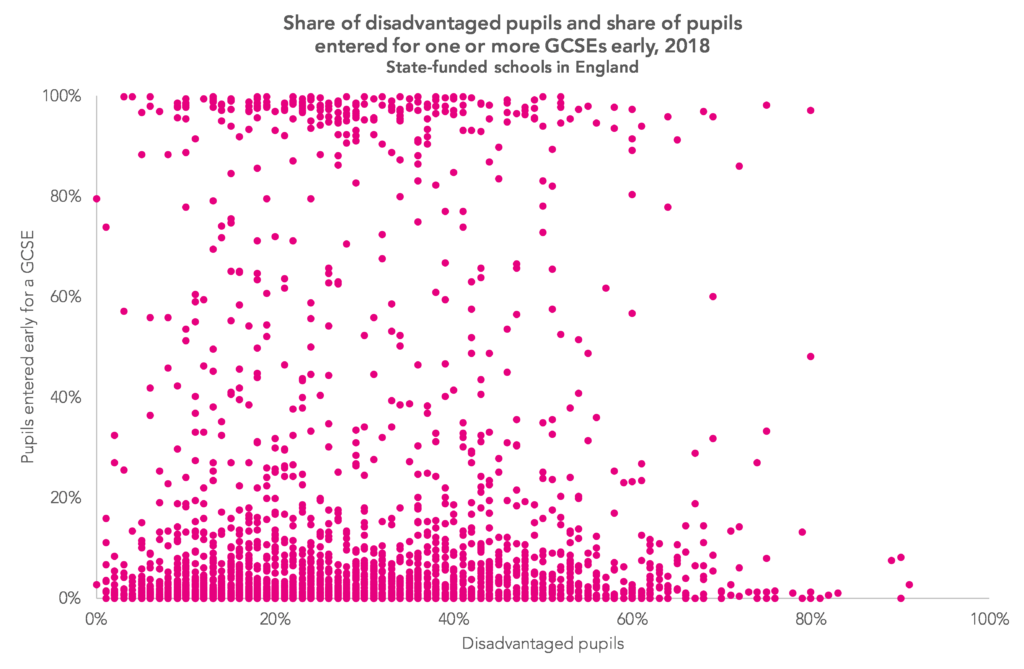On GCSE and A-Level results days it is often more interesting to look at changes in entries rather than attainment.
A note on coverage
Unless otherwise stated, all figures in this post relate to England only – though results for Wales and Northern Ireland will also be published on Thursday.
After all, the system of comparable outcomes ensures that attainment does not change too much from year to year.
Provisional 2019 entries data published earlier in the year by the exam regulator for England, Ofqual, showed a small increase in the number of GCSEs entered in Year 10 and earlier. This year there have been around 127,000 early entries, with the equivalent data last year showing 123,000. That said, national cohorts of pupils are growing in size.
The chart below gives the numbers of GCSE entries by pupils in Year 10 and below by subject in 2019. Only subjects with at least 1,000 entries are included. Science subjects are notable by their absence.

It is particularly in English language and English literature, religious studies, statistics and other modern languages[2] where early entry occurs.
But what effect does it have, and which schools are doing it?
Which schools entered pupils early?
To explore these questions, I’m going to look at 2018 end of Key Stage 4 data.
Reformed GCSEs (graded 9-1) were awarded for the first time in a large number of subjects – but not all of them – in 2018. Legacy (A*-G) GCSEs entered early by pupils (e.g. in Year 10 in 2017) in those subjects would therefore not count in school performance tables. Therefore, the 2018 data only gives us a partial picture of early entry.
But we nonetheless see that 12.5% (one in eight) of pupils who reached the end of Year 11 in state-funded mainstream schools entered at least one GCSE in Year 10 or earlier.[3]
When we look at how these pupils are distributed across schools, we see large variation.
The vast majority of schools (2,482 out of 3,150) entered fewer than 10% of their pupils for at least one GCSE early, of which 818 did not enter any at all.
By contrast, 211 schools entered at least 90% of their pupils for at least one early GCSE. Fewer than 7% of the national end-of-Key Stage 4 pupil population attend these schools, yet they are responsible for over half of the early GCSE entries.
However, early entry is only slightly correlated (r < 0.1) with a range of school characteristics such as prior attainment and percentage of disadvantaged pupils.
The chart below shows the relationship between disadvantage rate and the percentage of pupils early for GCSEs at school level.

What is the impact of early entry?
Let’s look at the 33,000 pupils (6.4% of the Key Stage 4 cohort) who entered either English language or English literature early.
Disadvantaged pupils were more likely to attend schools that enter pupils early and, consequently, a higher than average percentage (7.5%) were entered early in English.

Disadvantaged pupils who entered these subjects in Year 11 tended to achieve better grades than those who entered them in Year 10. The average point score for GCSEs entered in Year 10 was 4.17 compared to 4.54 in Year 11, the difference being equivalent to more than one-third of a grade.
We’ll be publishing live analysis of this year’s GCSE entries and attainment from 9.30am on Thursday. Sign up to our mailing list to get notifications about new blogposts, or check back here on the day.
In the meantime, check out our microsite, which allows you to explore trends in entries and attainment yourself. We’ll be adding 2019 data at 9.30am on Thursday.
- Physical education and religious studies include a small number of entries in short course GCSEs.
- All modern foreign languages other than French, German and Spanish.
- Pupils are also entered early in other types of qualification, but this post is only concerned with GCSEs.







I don;t know if it’s possible to group the underlying data by Academy Trust Sponsor to see if there are any policies strategies rather than pupil / school characteristics driving this. I assume a lot of the MFL are home / community languages which have often been taken in Year 10 as a stepping stone to an AS in Year 11 which is counted and potentially gives more performance points. Whilst researching something else recently I found a school which offered a three year KS4 with half the subjects sat at the end of year 10 (presumably after a full 2 years of teaching) and the other subjects examined at the end of year 11. It’s an interesting idea in terms of managing student stress and workload but must be particularly challenging to timetable and explain.
Hi Mike. Thanks for the comments. I suspect more of this will be apparent in the 2019 KS4 data as early entries in far more subjects assessed by reformed GCSEs will be counted this year (in the 2018 end of KS4 data we used, it was only English and maths among the reformed subjects that could be entered early). As for Trust level data, over 60% of pupils at the Outwood Grange Academies and Tauheedul Trust Academies were entered early but for all others it was <40%, so there's variation even within Trusts. Definitely worth looking at in the 2019 data.
Dear David, do you have a chart on not disadvantaged children and their attainment in yearly GCSEs?
Also, what was the number of students in Year 9 and Year 10 nest year registered for the exams? The numbers above provide the number of exam entries, but a students in Year 9 can do one or three GCSEs, so a number of psysical students who sit early GCSEs and students who sit Year 11 GCSES would have been very helpful. thank you